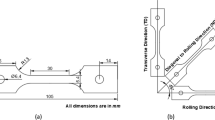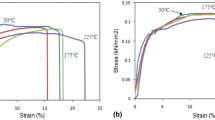Abstract
The objective of this study was to focus on the current state of finite element methods with respect to reliability in modeling of sheet metal forming processes. The trustworthiness of the FE simulations largely depends on the input material models used and correctness of the input material data. Formability parameters required for finite element analysis have been determined for Ti–6Al–4V alloy at temperature ranging from room temperature to 400 °C at intervals of 50 °C. Based on these formability parameters, various anisotropic yield criteria, namely, von-Mises, Hill 1948, Barlat 1989, Barlat 1996 and Cazacu–Barlat, have been implemented for Ti–6Al–4V alloy. In addition to that, circular deep drawing experiments have been performed in order to study the formability of Ti–6Al–4V alloy sheet at warm condition. It has been observed that formability of the material is very poor at room temperature. At temperatures above 150 °C till 400 °C, the limiting drawing ratio is found to be 1.8, which is substantially lesser than other structural alloys. Additionally, in the properly drawn cups, thickness distribution and earing tendency have been studied over the range of temperature. In order to validate the experimental results, finite element analysis has been done using commercially available software DYNAFORM version 5.6.1 with LSDYNA solver version 971. Also, failure regions during the experimentation have been identified using FE analysis. Comparison of yield criteria based on thickness distribution, earing profile, complexity in material parameter identification, and computational time has shown Cazacu–Barlat to be well suited for deep drawing of Ti–6Al–4V alloy.
Access this chapter
Tax calculation will be finalised at checkout
Purchases are for personal use only
Similar content being viewed by others
References
Abedrabbo N, Pourboghrat F, Carsley J (2007) Forming of AA 5182-O and AA 5754-O at elevated temperatures using coupled thermo-mechanical finite element models. Int J Plast 23:841–875
Altan T, Oh SI, Gegel HL (1983) Metal forming: fundamentals and applications. Am Soc Met 1:4–10
Atkinson M (1996) Accurate determination of biaxial stress–strain relationships from hydraulic bulging tests of sheet metals. Int J Mech Sci 39(7):761–769
Banabic D (2010) Sheet metal forming process: constitutive modeling and numerical simulations. Springer, Heidelberg
Barlat F, Lian J (1989) Plastic behaviour and strechability of sheet metals Part I: a yield function for orthotropic sheets under plane stress condition. Int J Plast 5:51–56
Barlat F, Brem JC et al (2003) Plane stress yield function for aluminium alloy sheet. Part 1 theory. Int J Plast 19:1297–1319
Beal JD, Boyer R, Sanders D (2006) The boeing company forming of titanium and titanium alloys. Metalworking Sheet Form 14 (ASM Handbook): 656–669
Bergström Y (1983) The plastic deformation of metals—a dislocation model and its applicability. Rev Powder Metall Phys Ceram 2:105–115
Bolt PJ, Lamboo NAPM, Rozier PJCM (2001) Feasibility of warm drawing of aluminum products. J Mater Process Technol 115:118–121
Bong HJ, Barlat F et al (2013) Formability of austenitic and ferritic stainless steels at warm forming temperature. Int J Mech Sci 75:94–109
Cazacu O, Plunkett B, Barlat F (2006) Orthotropic yield criterion for hexagonal closed packed metals. Int J Plast 22:1171–1194
Cole GS, Sherman AM (1995) Lightweight materials for automotive applications. Mater Charact 35:3–9
Davis JR (ed) (2004) Tensile testing, 2nd edn. ASM International, Ohio
Demmerle S, Boehler JP (1993) Optimal design of biaxial tensile cruciform specimens. J Mech Phys Solids 41(1):143–181
Djavanroodi F, Derogar A (2010) Experimental and numerical evaluation of forming limit diagram for Ti-6Al-4V titanium and Al6061-T6 aluminum alloys sheets. Mater Des 31:4866–4875
EI-Domiaty A (1992) The effect of strain, strain rate and temperature on formability of Ti-6Al-4V alloy. J Mater Process Technol 32:243–251
Güner A, Brosius A, Tekkaya AE (2009) Analysis of the hydraulic bulge test with FEA concerning the accuracy of the determined flow curves. Key Engineering Materials 410:439–447
Gupta AK, Anirudh VK, Singh SK (2013) Constitutive models to predict flow stress in austenitic stainless steel 316 at elevated temperatures. Mater Des 43:410–418
Gutscher G, Wu HC, Ngaile G, Altan T (2004) Determination of flow stress for sheet metal forming using the viscous pressure bulge (VPB) test. J Mater Process Technol 146:1–7
Hannon A, Tiernan P (2008) A review of planer biaxial tensile test system for sheet metal. J Mater Process Technol 198:1–13
Hill R (1950) The mathematical theory of plasticity. Clarendon, Oxford
Hollomon JH (1945) Trans AIME 162:268–290
Hosford W, Canddell R (2014) Metal forming mechanics and metallurgy, 3rd edn. Cambridge University Press, Cambridge, pp 52–75
Hussaini SM, Singh SK, Gupta AK (2014) Experimental and numerical investigation of formability for austenitic stainless steel 316 at elevated temperatures. J Mater Res Technol 3(1):17–24
Kaya S, Altan T, Groche P, Klöpsch C (2008) Determination of the flow stress of magnesium AZ31-O sheet elevated temperatures using hydraulic bulge test. Int J Mach Tools Manuf 48:550–557
Keefe AC, Carman GP, Jardine P (1998) Torsional behavior of shape memory alloys. Smart Struct Mater 3324:58–67
Keum YT, Ghoo BY, Waginer RH (2001) 3-Dimensional finite element analysis of non-isothermal forming processes for non-ferrous sheets. Simulation of materials processing: theory, methods and applications. A.A. Balkema, Lisse, pp 813–818
Koç Muammer, Billur Eren, Cora Ömer Necati (2011) An experimental study on the comparative assessment of hydraulic bulge test analysis methods. Mater Des 32:272–281
Kotkunde N, Deole AD et al (2014a) Failure and formability studies in warm deep drawing of Ti–6Al–4V alloy. Mater Des 60:540–547
Kotkunde N, Deole AD et al (2014b) Experimental and numerical investigation of anisotropic yield criteria for warm deep drawing of Ti–6Al–4V alloy. Mater Des 63:336–344
Kotkunde N, Krishnamurthy HN et al (2014c) Microstructure study and constitutive modeling of Ti–6Al–4V alloy at elevated temperatures. Mater Des 54:96–103
Kotkunde N, Deole AD et al (2014d) Comparative study of constitutive modeling for Ti–6Al–4V alloy at low strain rates and elevated temperatures. Mater Des 55:999–1005
Kurukuri S, van den Boogaard AH et al (2009) Warm forming simulation of Al–Mg sheet. J Mater Process Technol 209:5636–5645
Lange K (1985) Handbook of metal forming. McGraw-Hill, New York
Lee JY, Xu L, Barlat F et al (2013) Balanced biaxial testing of advanced high strength steels in warm conditions. J Exp Mech 53(9):1681–1692
Lin YC, Chen X-M (2011) A critical review of experimental results and constitutive descriptions for metals and alloys in hot working. Mater Des 32:1733–1759
LS-DYNA Keyword User’s Manual (2007) Volume 1, Livermore Software Technology Corporation (LSTC). (http://lstc.com/pdf/ls-dyna_971_manual_k.pdf)
Ludwik P (1909) Elemente der Technologischen Mechanik. Verlag Von Julius Springer, Leipzig, p 32
Marciniak Z (2002) Mechanics of sheet metal forming. Butterworth-Heinemann, Oxford
Marciniak Z, Kuczyński K, Pokora T (1973) Influence of the plastic properties of a material on the forming limit diagram for sheet metal in tension. Int J Mech Sci 15(10):789–800
Mishra NS, Mishra S, Ramaswamy V (1989) Analysis of the temperature dependence of strain-hardening behavior in high-strength steel. Metall Trans A 20:2819
Naka T, Yoshida F (1999) Deep drawability of type 5083 aluminum–magnesium alloy sheet under various conditions of temperature and forming speed. J Mater Process Technol 89(90):19–23
Nielsen KB (2000) sheet metal forming simulation using explicit finite element methods, 3rd edition, Aalborg University, Denmark
Odenberger E-L, Schill M, Oldenburg M (2013) Thermo-mechanical sheet metal forming of aero engine components in Ti–6Al–4V—part 2: constitutive modelling and validation. Int J Mater Form 6:403–416
Olovsson L, Simonsson K, Unosson M (2005) Selective mass scaling for explicit finite element analyses. Int J Numer Meth Eng 63(10):1436–1445
Pearce R (1968) Some aspects of anisotropic plasticity in sheet metals. Int J Mech Sci 10(12):995–1004
Singh SK, Mahesh K et al (2010) Understanding formability of extra-deep drawing steel at elevated temperature using finite element simulation. Mater Des 31:4478–4484
Swift HW (1952) Plastic instability under plane stresses. J Mech Phys Solids 1:1–18
Takuda H, Mori K et al (2003) Finite element analysis of the formability of an austenitic stainless steel sheet in warm deep drawing. J Mater Process Technol 143:242–248
Toros S, Ozturk F, Kacar I (2008) Review of warm forming of aluminum–magnesium alloys. J Mater Process Technol 207:1–12
Van den Boogaard AH, Huétink J (2006) Simulation of aluminium sheet forming at elevated temperatures. Comput Methods Appl Mech Eng 195:6691–6709
Vlassak JJ, Nix WD (1992) A new bulge test technique of Young’s modulus and Poisson’s ratio of thin films. J Mater Res 7(12):3242–3249
Voce E (1948) J Inst Met 74:537–562
Wessel JK (2004) Handbook of advanced materials Hoboken. Wiley, Hoboken
Wierzbicki T, Bao Y et al (2005) Calibration and evaluation of seven fracture models. Int J Mech Sci 47(4–5):719–743
**ang-Dong W, Wan M, **an-Bin Z (2005) Biaxial tensile testing of cruciform specimen under complex loading. J Mater Process Technol 168:181–183
Zhang SH et al (2007) Deep-drawing of magnesium alloy sheets at warm temperatures. J Mater Process Technol 185:147–151
Acknowledgments
The financial support received for this research work from Department of Science and Technology (DST), Government of India, SERB-DST, SR/FTP/ETA-0056/2011 is gratefully acknowledged.
Author information
Authors and Affiliations
Corresponding author
Editor information
Editors and Affiliations
Rights and permissions
Copyright information
© 2015 Springer India
About this paper
Cite this paper
Kotkunde, N., Deole, A.D., Gupta, A.K., Singh, S.K. (2015). Numerical Analysis of Warm Deep Drawing for Ti–6Al–4V Alloy . In: Narayanan, R., Dixit, U. (eds) Advances in Material Forming and Joining. Topics in Mining, Metallurgy and Materials Engineering. Springer, New Delhi. https://doi.org/10.1007/978-81-322-2355-9_6
Download citation
DOI: https://doi.org/10.1007/978-81-322-2355-9_6
Published:
Publisher Name: Springer, New Delhi
Print ISBN: 978-81-322-2354-2
Online ISBN: 978-81-322-2355-9
eBook Packages: EngineeringEngineering (R0)




